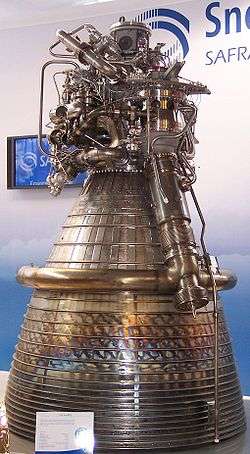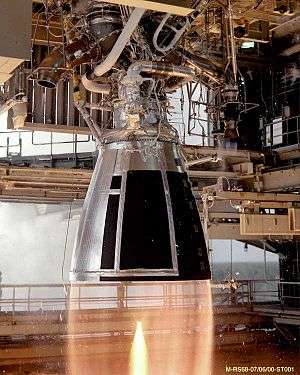Vulcain (rocket engine)
Vulcain is a family of European first stage rocket engines for Ariane 5 and the future Ariane 6. Its development began in 1988 and the first flight was completed in 1996. The updated version of the engine, Vulcain 2, was first successfully flown in 2005. Both members of the family use liquid oxygen/liquid hydrogen cryogenic fuel. The new version under development for Ariane 6 will be called Vulcain 2.1.
 Vulcain 1 engine on display at Musée des Sciences et des Techniques de la Villette | |
| Country of origin | |
|---|---|
| First flight | 04 June 1996 |
| Last flight | 18 December 2009 |
| Designer | Snecma |
| Manufacturer | Safran Aircraft Engines |
| Application | Main stage engine |
| Associated L/V | Ariane 5 |
| Successor | Vulcain 2 |
| Status | Retired |
| Liquid-fuel engine | |
| Propellant | Liquid oxygen / Liquid hydrogen |
| Mixture ratio | 5.3 |
| Cycle | Gas generator |
| Configuration | |
| Nozzle ratio | 45.1 |
| Performance | |
| Thrust (vac.) | 1,140 kN (256,300 lbf) |
| Chamber pressure | 100 bars (1,500 psi) |
| Isp (vac.) | 431 s (4.23 km/s) |
| Dimensions | |
| Length | 3.05 m (10.0 ft) |
| Diameter | 1.76 m (5.8 ft) |
| Dry weight | 1,300 kg (2,900 lb) |
| Used in | |
| Ariane 5 G and GS | |
| References | |
| References | [1][2][3][4] |
 The Vulcain 2 engine | |
| Country of origin | |
|---|---|
| First flight | 12 February 2005 |
| Designer | Snecma |
| Manufacturer | Snecma |
| Application | Main stage engine |
| Associated L/V | Ariane 5 |
| Predecessor | Vulcain 1 |
| Status | In use |
| Liquid-fuel engine | |
| Propellant | Liquid oxygen / Liquid hydrogen |
| Mixture ratio | 6.1 |
| Cycle | Gas generator |
| Configuration | |
| Nozzle ratio | 58.2 |
| Performance | |
| Thrust (vac.) | 1,359 kN (305,500 lbf) |
| Chamber pressure | 117.3 bars (11.73 MPa) |
| Isp (vac.) | 429 s (4.21 km/s) |
| Dimensions | |
| Length | 3.44 m (11.3 ft) |
| Diameter | 2.09 m (6.9 ft) |
| Dry weight | 1,800 kg (4,000 lb) |
| Used in | |
| Ariane 5 ECA, ES | |
| References | |
| References | [1][5] [6][7][8] |
| Notes |  Test firing of the Vulcain 2 engine in May 2004 |
| Country of origin | |
|---|---|
| Designer | Snecma |
| Manufacturer | Snecma |
| Application | Main stage engine |
| Associated L/V | Ariane 6 |
| Predecessor | Vulcain 2 |
| Status | In development |
| Liquid-fuel engine | |
| Propellant | Liquid oxygen / Liquid hydrogen |
| Cycle | Gas generator |
| Performance | |
| Thrust (vac.) | 1,324 kN (297,600 lbf) |
| Chamber pressure | 120.8 bars (12.08 MPa) |
| Dimensions | |
| Length | 3.7 m (12 ft) |
| Diameter | 2.5 m (8.2 ft) |
| Dry weight | 2,000 kg (4,400 lb) |
| Used in | |
| Ariane 6 | |
| References | |
| References | http://www.esa.int/spaceinimages/Images/2017/10/Vulcain_2.1 |
History
The Vulcain rocket engine is named in French for Vulcan, the ancient Roman god of fire. Its development, carried out by a European partnership, began in 1988 with the Ariane 5 rocket program.[9] It first flew in 1996 powering the ill-fated flight 501 without being the cause of the disaster, and had its first successful flight in 1997 (flight 502).
In 2002 the upgraded Vulcain 2 with 20% more thrust[10] first flew on flight 517, although a problem with the engine turned the flight into a failure.[11] The cause was due to flight loads being much higher than expected, as the inquiry board concluded.[12] Subsequently, the nozzle was redesigned to include mechanical reinforcement of the structure and improvement of the thermal situation of the tube wall through enhancing hydrogen coolant flow as well as applying a thermal barrier coating to the flame-facing side of the coolant tubes.[12] The first successful flight of the (partially redesigned) Vulcain 2 occurred in 2005 on flight 521.[11]
Further development
On 17 June 2007 Volvo Aero announced that in spring of 2008 it expected to hot-fire test a Vulcain 2 nozzle manufactured with a new "sandwich" technology.[13]
The development of the future version for Ariane 6, Vulcain 2.1, began in 2014. First flight-configuration engine nozzle was delivered in June 2017, reducing parts count by 90%, cost by 40% and production time by 30% comparing to the engine nozzle of Vulcain 2.[14]
Overview
The Vulcain is a gas-generator cycle rocket engine fed with cryogenic liquid oxygen and liquid hydrogen. It features regenerative cooling through a tube wall design, and the Vulcain 2 introduced a particular film cooling for the lower part of the nozzle, where exhaust gas from the turbine is re-injected in the engine.[12] It powers the first stage of the Ariane 5 launcher, the EPC (Étage Principal Cryotechnique, main cryogenic stage) and provide 8% of the total lift-off thrust[15] (the rest being provided by the two solid rocket boosters). The engine operating time is 600 s in both configurations.[16] 3 m tall and 1.76 m in diameter, the engine weighs 1686 kg and provides 137 t of thrust in its latest version.[17] The oxygen turbopump rotates at 13600 rpm with a power of 3 MW while the hydrogen turbopump rotates at 34000 rpm with 12 MW of power. The total mass flow rate is 235 kg/s, of which 41.2 kg/s are of hydrogen.
Contractors
The main contractor for the Vulcain engines is Snecma Moteurs (France), which also provides the liquid hydrogen turbopump. The liquid oxygen turbopump is the responsibility of Avio (Italy), and the gas turbines that power the turbopumps and the nozzle are developed by GKN (Formerly Volvo) (Sweden).[15]
See also
References and notes
- "Vulcain-2 Cryogenic Engine Passes First Test with New Nozzle Extension" (PDF). www.esa.int. Retrieved 18 November 2018.
- EADS Astrium. "Vulcain Rocket Engine - Thrust Chamber". Airbus Defence and Space. Archived from the original on 25 February 2012. Retrieved 20 July 2014.
- "V169 Presskit" (PDF). Arianespace. Archived from the original (PDF) on 12 December 2010. Retrieved 30 June 2015.
- "Vulcain". Astronautix. Retrieved 30 June 2015.
- EADS Astrium. "Vulcain 2 Rocket Engine - Thrust Chamber". Airbus Defence and Space. Archived from the original on 27 March 2012. Retrieved 20 July 2014.
- "Ariane 5 - Europe's Heavy Launcher" (PDF). European Space Agency. Retrieved 20 July 2014.
- "Vulcain®2". Safran. Retrieved 5 October 2014.
- "Vulcain 2". Astronautix. Retrieved 30 June 2015.
- "Vulcain – Summary". SPACEandTECH. Archived from the original on 2012-03-29. Retrieved 2006-12-16.
- "Vulcain 2 engine now in full production". European Space Agency. 2005-04-05. Retrieved 2006-12-16.
- "Ariane 5 Data Sheet". Space Launch Report. 2005-11-29. Retrieved 2006-12-15.
- L. Winterfeldt, Volvo Aero Corporation, Trollhättan, Sweden; B. Laumert, Volvo Aero Corporation, Trollhättan, Sweden; R. Tano, Volvo Aero Corporation, Trollhättan, Sweden; P. James, Snecma, Vernon, France; F. Geneau, Snecma, Vernon, France; R. Blasi, EADS Space Transportation, Ottobrunn, Germany & G. Hagemann, EADS Space Transportation, Ottobrunn, Germany (2005-07-10). "Redesign of the Vulcain 2 Nozzle Extension" (PDF). American Institute of Aeronautics and Astronautics. Retrieved 2012-07-04.CS1 maint: multiple names: authors list (link)
- "Volvo Aero's sandwich space technology passes important milestone" (Press release). Volvo Aero. June 17, 2007. Archived from the original on July 17, 2011.
- "GKN delivers revolutionary Ariane 6 Nozzle to Airbus Safran Launchers" (Press release). GKN Aerospace. 20 June 2017. Retrieved 23 June 2017.
- "ESA – Launch Vehicles – Vulcain Engine". European Space Agency. 2005-11-29. Retrieved 2006-12-16.
- "Volvo Aero: Vulcain – characteristics". Volvo Aero. Retrieved 2007-05-12.
- "ESA – Launch Vehicles – Ariane 5 ECA". European Space Agency. Retrieved 2006-12-16.
External links
| Wikimedia Commons has media related to Vulcain. |
- Arianespace – Ariane 5: Cryogenic Main Stage and Solid Boosters
- Ariane 5 ECA and Snecma – Snecma Moteurs: Vulcain 2 engine proves its mettle
- "LH2 Turbine (Vulcain and Vulcain 2 engines)" (PDF). Archived from the original (PDF) on 22 March 2011. – Volvo Aero
- "LOX Turbine (Vulcain and Vulcain 2 engines)" (PDF). Archived from the original (PDF) on 1 January 2011. – Volvo Aero
- "Development of the turbines for the Vulcain 2 turbopumps" (PDF). Archived from the original (PDF) on 2007-09-30. – Volvo Aero
- "High cycle fatigue of Vulcain 2 LOx turbine blades" (PDF). Archived from the original (PDF) on 2007-09-27. – Volvo Aero
- "An efficient concept design process" (PDF). Archived from the original (PDF) on 2007-09-27. – Volvo Aero
- "Vulcain 2 nozzle" (PDF). Archived from the original (PDF) on 22 March 2011. – Volvo Aero

.jpg)